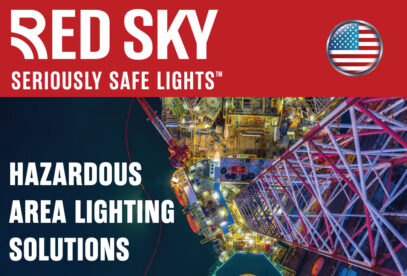Red Sky Lighting: Explosion-Proof LED Lighting for ATEX/IECEx Hazardous Areas
When you’re lighting hazardous locations, “good enough” isn’t good enough. You need explosion proof lighting that’s certified, efficient, and built to last in corrosive, high-vibration, and extreme-temperature environments. Red Sky Lighting delivers exactly that—robust explosion proof LED light solutions engineered for oil & gas, petrochemical, marine & offshore, wastewater, and heavy industry.
Why explosion-proof matters
In hazardous areas, a spark or high surface temperature can ignite gases or dust. Explosion proof LED light fixtures contain any internal ignition and maintain safe surface temperatures, reducing risk while maintaining visibility and uptime.
Key certifications & classifications
-
ATEX and IECEx compliance for Zones 1/2 (gas) and 21/22 (dust)
-
Temperature classes and gas groups appropriate to your site
-
IP66/67 ingress protection and robust impact ratings (model dependent)
Tip: Always match the fixture’s zone rating to your site’s classification and consult your HSE/engineering team before final selection.
Core product families
-
Explosion proof flood light / ex proof LED flood light
Wide-area illumination for process units, loading bays, and perimeter lighting. -
Explosion proof linear light / explosion proof LED linear light
Perfect for corridors, catwalks, and enclosed spaces; slim profile, uniform light. -
Explosion proof high bay light
High-output lighting for tall structures, warehouses, and fabrication halls. -
Explosion proof emergency light / explosion proof LED emergency light
Battery-backed egress lighting for safe evacuation during power loss. -
Hazardous area light fittings & accessories
Brackets, diffusers, and optics to tailor beam angles and mounting.
What sets Red Sky Lighting apart
-
Reliability in extremes – Corrosion-resistant housings, marine-grade finishes, sealed optics.
-
High efficacy – Modern drivers and LEDs reduce energy use and carbon footprint.
-
Optics that fit the job – Flood, narrow, and asymmetric distributions to cut glare and spill.
-
Maintenance made simple – Modular design, accessible drivers/LED boards, and fewer relamping cycles.
-
Compliance documentation – Datasheets, certificates, and IOMs to speed up approvals.
Where these fixtures excel
-
Offshore platforms, FPSOs, refineries, and gas processing
-
Petrochemical plants, paint shops, chemical warehouses
-
Wastewater treatment, food processing (dust risks), grain handling
-
Tunnels, utilities, and general hazardous maintenance zones
Selecting the right fixture (quick guide)
-
Identify the zone & dust/gas group (e.g., ATEX Zone 1/21).
-
Define the task (flooding an area vs. aisle lighting → flood vs. linear).
-
Set illuminance targets (lux) and choose the beam and mounting height.
-
Check temperature class (T-rating), IP rating, and materials for your environment.
-
Plan for emergencies with explosion proof emergency light coverage.
ATEX floodlight & linear options for upgrades
Modern ATEX floodlight and ATEX approved LED lighting options from Red Sky Lighting make metal-halide-to-LED replacements straightforward. Expect faster strike times, better color rendering, and lower maintenance—without compromising safety.
Work with Daly Middle East
As a regional distributor, we support you with site-appropriate product selection, lighting layouts (on request), documentation for approvals, and after-sales service. If you’re upgrading to LED explosion proof lamp solutions or specifying new builds, we’ll help you choose the right hazardous area light fittings for performance, compliance, and cost.
Ready to specify explosion proof LED light fixtures? Contact us for datasheets, photometry, and a tailored quotation.
Have got any questions, we have an answers to it.
Q1. What is explosion-proof LED lighting?
Explosion-proof lighting is designed so any internal ignition is contained within the fixture, preventing flame or sparks from igniting the surrounding atmosphere. It’s essential for areas with flammable gases, vapors, or dust.
Q2. Is ATEX the same as IECEx?
Both are international conformity schemes for hazardous locations. ATEX is mandated in the EU, while IECEx is a global certification scheme. Many Red Sky fixtures carry both to simplify cross-border projects.
Q3. Flood light vs. linear vs. high bay—how do I choose?
Use explosion proof flood lights for open areas, explosion proof linear light for aisles and corridors, and explosion proof high bay light for tall spaces. Match optics and lumen output to your target lux and mounting height.
Q4. Do I need emergency versions?
If your risk assessment requires safe egress during power loss, specify explosion proof emergency light or explosion proof LED emergency light with appropriate autonomy (e.g., 90 minutes) and spacing.
Q5. What IP rating should I look for?
IP66/67 is common for outdoor or washdown environments. Higher IP ratings improve protection against dust and water ingress.
Q6. Can these fixtures be used in dusty sites (Zone 21/22)?
Yes—look for dust certifications and suitable temperature classes. Flood light explosion proof and explosion proof LED linear light models are often selected for dusty conveyors and silos.
Q7. How do I replace metal halide with LED?
Match (or improve) your target lux using LED photometric files. LED usually needs fewer watts for the same light, and ex proof lighting reduces maintenance and operating cost.
Q8. What documentation is provided?
Datasheets, ATEX/IECEx certificates, IOM manuals, and photometry (IES/LDT). Ask us for a submittal pack.
Q9. What about color temperature and CRI?
4000–5000K is typical for industrial clarity; higher CRI aids inspection tasks. We’ll help you choose based on process needs.
Q10. How long do explosion-proof LEDs last?
L70 lifetimes of 50,000–100,000 hours are common (model dependent). Thermal design and ambient temperature affect longevity.
